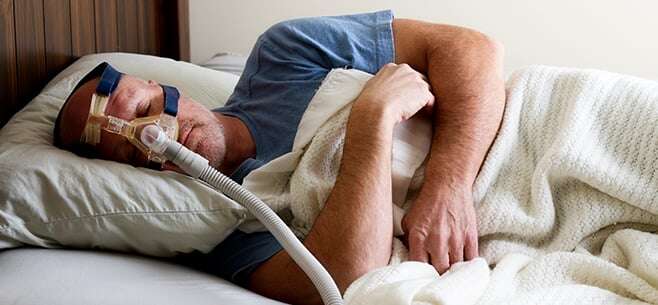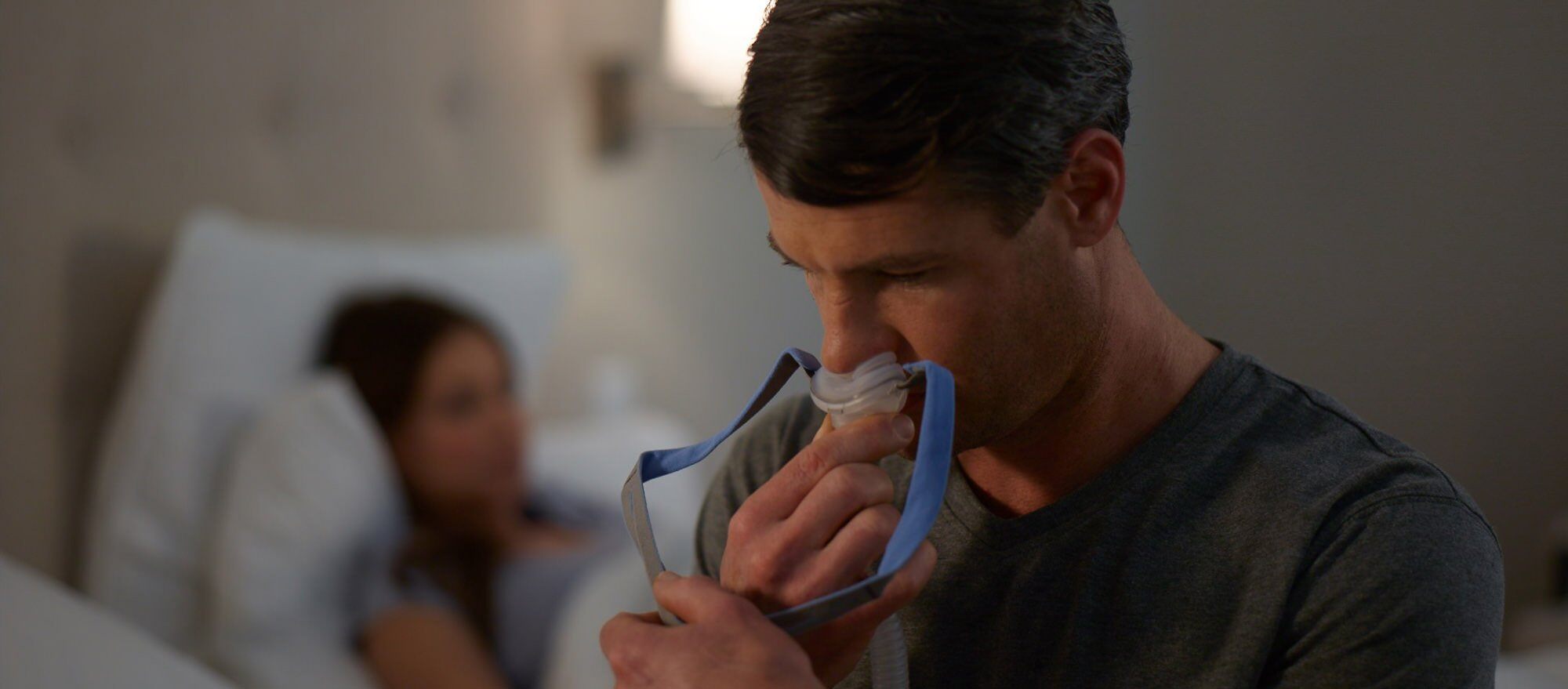A CPAP (Continuous Positive Airway Pressure) Machine offers you relief from Sleep Apnea, so you can get a better sleep every night and experience the health benefits that this brings. But in order for it to continue to be a successful part of your sleep apnea therapy, it is important to ensure that the mask and tube are comfortable and working correctly to maximise its efficacy.
In this blog, we discuss how to best manage your mask and tubing to get the best results.
THE CPAP MASK AND TUBING
The headgear of a CPAP machine consists of a mask and tube piece connected to the main device which blows pressurised air in order to keep your airways open while you sleep. All these parts contribute to the way the device works and your treatment.
We will have a look at all the common mask and tubing issues, and how you can troubleshoot them so you can get the most out of your nightly treatment.
HOW TO SELECT THE CORRECT CPAP MASK FOR YOU
The first step is to choose the perfect mask to fit you.
Trying On Your CPAP Mask
 CPAP masks come in a variety of styles and sizes to suit the needs of many patients. It's important to choose a mask that's comfortable, otherwise you may find yourself not wanting to use it every night, which can compromise your treatment progress. Although you will be guided through this process by your Sleep Professional, it’s ultimately a hands-on decision. We recommend taking the time to personally try on as many masks as you can. Only you can truly know for sure what fits well.
CPAP masks come in a variety of styles and sizes to suit the needs of many patients. It's important to choose a mask that's comfortable, otherwise you may find yourself not wanting to use it every night, which can compromise your treatment progress. Although you will be guided through this process by your Sleep Professional, it’s ultimately a hands-on decision. We recommend taking the time to personally try on as many masks as you can. Only you can truly know for sure what fits well.
Different Types Of Masks
Full Face Masks cover your nose and mouth and are ideal for mouth breathers and those with nasal obstructions or frequent congestion.
Nasal Masks are triangular in shape and are worn over the nose. They are available in a wide variety of sizes.
A nasal pillow mask rests at the entrance of your nostrils, and is the most compact of all CPAP masks.
The mask type that best suits you depends greatly on personal requirements and preferences. Some factors that you may want to take into consideration are your facial anatomy, the presence of any facial hair, and even if know yourself to be a little claustrophobic. Each mask has its own benefits and use, and you should try on various mask styles and decide which is best for you. Don’t be afraid to be honest, as you want to be as comfortable as possible during your treatment at all times.
CHANGING MASK TYPE AND SETTINGS
There may be situations where you need to alternate between masks to accommodate different circumstances. For example, the nasal mask may not be an option when you have a cold, or the full-face may not be the best option when you travel.
Every mask has slightly different characteristics based on different situations, so keep in mind that when you switch CPAP masks, you may need to go into the user menu of your CPAP machine and change your mask type and setting..
When considering masks for use with your CPAP machine, be sure that they are fully compatible, to ensure that it functions properly and that it does not compromise your sleep apnea therapy.
NASAL PILLOWS
The smallest member of the CPAP Mask family. Their minimal design makes them a popular choice.HOW TO BEST FIT YOUR MASK
Properly fitting your mask is an essential step toward comfortable therapy. After all, a CPAP machine’s success relies on your use of the mask and tubing . Both consistency and compliance of use are the two most important ways that a patient can maximise the machine’s efficacy when it comes to sleep apnea.
Consistency comes from using the machine during every sleep as instructed, and compliance means using it as intended.
The Importance Of The Right Fit

Your mask may not fit you correctly if you are not putting on the headgear in the right manner. Small adjustments can make all the difference to comfort and effectiveness. If you are having difficulties contact us r and we will be happy to show you the best way to arrange your tube and put on your mask so that it fits perfectly to the contours of your face the way it is designed to do.
If you experience difficulties, you can refer to your mask user guide for complete fitting instructions. Just remember that facial muscles change when we lie down and relax, and even more so once we're asleep, so it's always best to fit the mask while you're in your usual sleeping position.
Keeping The Mask On Throughout the Night
![]() Some patients find themselves removing their mask while sleeping without even realising it.
Some patients find themselves removing their mask while sleeping without even realising it.
Every person adapts to their therapy differently, and there may be various contributing factors requiring a personalised approach..
Consider asking your partner to keep an eye out for you, to see if they notice when you do it. It may help you find a solution if you know what is happening, whether you are removing it as you toss and turn, perhaps out of discomfort, or simply out of habit. If you still have concerns , contact us and arrange a consultation.
CPAP Mask Application Using The Straps
It's important not to over-tighten your mask, especially if you are doing it to overcompensate for a wrong size and it’s causing you pain. Doing so may be a sign that you have the wrong cushion size or an incorrectly adjusted forehead support. If you experience difficulties in fitting your mask, please refer to your mask user guide for complete fitting instructions, or contact us to discuss your concerns.
CPAP Mask Leakage
 Hearing or feeling mask leaks of any amount should not be ignored. Your CPAP machine treats your sleep apnea each night by using air pressure to keep your throat open throughout the hours of sleep so that there is a constant stream of oxygen going into your airways. The loss of that air pressure due to a leak in a seal means your treatment is compromised.
Hearing or feeling mask leaks of any amount should not be ignored. Your CPAP machine treats your sleep apnea each night by using air pressure to keep your throat open throughout the hours of sleep so that there is a constant stream of oxygen going into your airways. The loss of that air pressure due to a leak in a seal means your treatment is compromised.
So you might be doing the right thing by using the CPAP machine, but not getting the results from your treatment.
It’s best to first refer to the troubleshooting section in your mask user guide. Mask leakage may indicate one of several things, including:
- incorrect adjustment
- incorrect assembly
- incorrect size
- your mask is worn out and needs replacement
Ensure the mask is fitted to your face snugly to create an air pressure seal. If you feel that there is a seepage of air, or you find that your sleep apnea symptoms unexplainably return, it’s time to get in contact with us and find out what is causing the issues.
Keep in mind that over time, CPAP masks experience normal wear and tear which can cause their shapes to warp, compromising the seal against your face. Seals can also be damaged due to being in constant contact with skin oils, creams and even makeup. If this is the case, the integrity of the seal can become compromised which can also cause leaks. In this situation, you may need to replace the old mask with a new one, to ensure that your treatment remains effective every time you wear the headgear.
GETTING COMFORTABLE WITH YOUR CPAP MASK
Now that you have the right mask and the right fit, it’s time to get comfortable with it.
If you are experiencing discomfort, try these three tips:
- Remove the mask and try putting it on again. Mask discomfort can be caused by incorrect application the first time. In the case of discomfort, we recommend that you re-fit the mask using the instructions in your mask user guide, just to check you are getting it right. It doesn’t hurt to be sure!
- Try a different size. If you can only get a good seal by tightening the mask until it's uncomfortable, then you may have the wrong size. Arrange an appointment to come in and review your mask fitting. It’s worth it for the benefits of having effective sleep apnea treatment each night.
- If your mask still feels uncomfortable, you might need another type of mask. There are a variety of mask types, and you'll find that some masks may suit you better than others.
CPAP Mask and Facial Hair
 Sometimes, patients are concerned that growing their facial Sometimes, patients are concerned that growing their facial hair may cause issues with using the mask each night. The truth is that it may.
Sometimes, patients are concerned that growing their facial Sometimes, patients are concerned that growing their facial hair may cause issues with using the mask each night. The truth is that it may.
If you have facial hair, you may find that some masks work better for you than others. Discuss with us about whether a different style of mask may provide improved comfort or a better fit.
Weight Changes and CPAP Mask Use
![]() Gaining or losing weight can also change the shape of your face, which can lead to your mask no longer fitting properly. Never underestimate these subtle changes and then overcompensate by forcing the mask onto your face, as you will experience discomfort and may be tempted to stop treatment. Instead, speak get in touch so we can find out more about your requirements and test out new mask sizes, as needed.
Gaining or losing weight can also change the shape of your face, which can lead to your mask no longer fitting properly. Never underestimate these subtle changes and then overcompensate by forcing the mask onto your face, as you will experience discomfort and may be tempted to stop treatment. Instead, speak get in touch so we can find out more about your requirements and test out new mask sizes, as needed.
Choosing The Best CPAP Mask Type
![]() While there are a range of different mask types, everyone is different when it comes to which feels most comfortable. Full-face masks cover more of your face and may feel more secure, while nasal masks and nasal pillows masks cover less, but may feel less intrusive. It really does come down to personal preference and which type of mask best suits your needs, so chose the one you prefer.
While there are a range of different mask types, everyone is different when it comes to which feels most comfortable. Full-face masks cover more of your face and may feel more secure, while nasal masks and nasal pillows masks cover less, but may feel less intrusive. It really does come down to personal preference and which type of mask best suits your needs, so chose the one you prefer.
Skin Irritation
In rare occasions, a mask may leave marks on your face or irritate your skin. There are many possible reasons for these kinds of reactions to your mask, some of which are not related to allergies. It’s best to consult your Doctor if you are experiencing skin irritation or sores due to wearing your mask, especially if it is occurring regularly.
Deviated Septum and Nose Blockage
![]() Just like when you have a cold or sinus issues, with a deviated septum, you're likely to be breathing through your mouth because your nasal passage is blocked. Therefore, it’s best to switch to a full face mask, which will allow you the option of breathing through both your nose or mouth.
Just like when you have a cold or sinus issues, with a deviated septum, you're likely to be breathing through your mouth because your nasal passage is blocked. Therefore, it’s best to switch to a full face mask, which will allow you the option of breathing through both your nose or mouth.
MANAGING THE MASK’S TUBE
Sometimes the tube behind the mask can be a concern. The tube’s function is an essential part of your treatment because it connects the mask to the CPAP machine, but it can often be inconvenient and get in the way during the night.
If you find that you are becoming frustrated by the presence of the tube, we recommend a contoured pillow, or a pillow with a ‘memory-foam’ that holds its shape. This type of pillow can be quite effective for CPAP users, because the ribbed grooves on both sides allow you to rest your head comfortably, while the tube sits away from you, and not across your pillow. Pillows that use memory foam allow you to adjust the shape to create a groove where the tube can lie, which keeps it in a convenient location throughout the night.
WANT TO KNOW MORE ABOUT CPAP MACHINES AND ACCESSORIES?
Understanding what mask options are available, how CPAP machines work, and how you can get the best treatment outcomes from your device can help you to make the right choice when you’re ready to select a sleep apnea therapy machine.
Visit our online store to explore our wide range of CPAP machine and masks, as well as accessories. Get in touch with us today to find out more information about troubleshooting your CPAP mask.
.webp?width=1158&height=143&name=Combined%20logo%20-%20Ecom%20Main%20300x200%20(1).webp)




